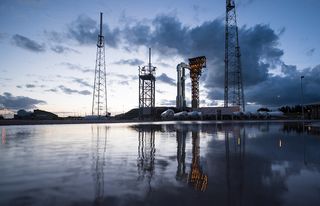Widespread Texas power outages delay Boeing's second Starliner spacecraft test flight to April
It is now set to launch April 2.

NASA's commercial crew program hit another delay in getting a second spacecraft ready to ferry astronauts to space.
The second uncrewed test of Boeing's CST-100 Starliner has been delayed from no earlier than March 25 to no earlier than April 2 "to allow more time for spacecraft and hardware processing," according to a NASA update to its commercial crew website Wednesday (Feb. 17).
Teams in Houston are also dealing with widespread power outages due to severe winter storms in the past week affecting the Texas electricity grid, Boeing said in its own statement.
Related: Boeing's 1st Starliner flight test in photos
History of NASA: $22.99 at Magazines Direct
Discover the story of how and why NASA was created, its greatest triumphs, darkest days, and of the times it exceeded all possible hopes. A tale of adventure, heroism and resourcefulness, learn of the space agency's greatest achievements and how — over six decades — the organization has consistently and tirelessly devoted itself to its founding principle: that "activities in space should be devoted to peaceful purposes for the benefit of all humankind".
The Starliner program is trying to recover from an unsuccessful test flight that took place in late 2019. The flight was marred with software glitches and the uncrewed spacecraft failed to reach the International Space Station, landing safely on Earth after a shortened flight. NASA identified 80 items that needed correction before another flight could take place. Boeing has spent the last 14 months systematically addressing these concerns, but the teams determined they need more time.
"With formal software tests completed, Boeing is continuing with flight preparations. We are ready to conduct a mission rehearsal, using flight hardware and final flight software, to ensure the readiness of the team and combined systems," Boeing stated.
"Hardware processing is also concluding. We recently moved the spacecraft into the hazardous processing area in anticipation of propellant load. We continue to address final observations and have successfully replaced avionics units affected by a power surge during final checkouts. We continue to ensure product safety of our spacecraft and we are addressing any emerging issues in a timely manner."
Get the Space.com Newsletter
Breaking space news, the latest updates on rocket launches, skywatching events and more!
Boeing has addressed 95% of the recommendations from the Orbital Flight Test review team that examined the flawed December 2019 flight, according to the NASA statement. However, the team does not want to rush the second test flight. "Even though this [new] uncrewed flight test to the International Space Station is a key milestone on the path to the first Starliner crewed mission planned for later this year, we will fly when we are ready," Steve Stich, manager of NASA's Commercial Crew Program, said in the statement.
Starliner is a part of NASA's long-term plans to increase crew size on the ISS, which dropped after the aging NASA space shuttle fleet retired in 2011. Space shuttles could carry about seven people for short-term flights, compared with the Russian Soyuz spacecraft replacements that have a maximum of three seats but are rated to stay in orbit for several months. Rather than replace space shuttles, NASA decided to hire commercial companies to fly astronauts into orbit.
SpaceX and Boeing spent several years developing spacecraft in a competitive process with other companies, ahead of a 2014 decision by NASA to split the $6.8 billion Commercial Crew Transportation Capability award between them for eventual crew flights.
Last year, fellow commercial crew awardee SpaceX successfully launched both a crewed test flight and an operational flight of its Crew Dragon to the ISS. Crew Dragon and Starliner are rated to carry at most four astronauts per flight for long-duration missions. Larger crews in space can conduct more science on the ISS; the international partnership that runs the orbital laboratory is discussing possibly extending operations beyond a current end date of 2024.
Follow Elizabeth Howell on Twitter @howellspace. Follow us on Twitter @Spacedotcom and on Facebook.
Join our Space Forums to keep talking space on the latest missions, night sky and more! And if you have a news tip, correction or comment, let us know at: community@space.com.

Elizabeth Howell (she/her), Ph.D., is a staff writer in the spaceflight channel since 2022 covering diversity, education and gaming as well. She was contributing writer for Space.com for 10 years before joining full-time. Elizabeth's reporting includes multiple exclusives with the White House and Office of the Vice-President of the United States, an exclusive conversation with aspiring space tourist (and NSYNC bassist) Lance Bass, speaking several times with the International Space Station, witnessing five human spaceflight launches on two continents, flying parabolic, working inside a spacesuit, and participating in a simulated Mars mission. Her latest book, "Why Am I Taller?", is co-written with astronaut Dave Williams. Elizabeth holds a Ph.D. and M.Sc. in Space Studies from the University of North Dakota, a Bachelor of Journalism from Canada's Carleton University and a Bachelor of History from Canada's Athabasca University. Elizabeth is also a post-secondary instructor in communications and science at several institutions since 2015; her experience includes developing and teaching an astronomy course at Canada's Algonquin College (with Indigenous content as well) to more than 1,000 students since 2020. Elizabeth first got interested in space after watching the movie Apollo 13 in 1996, and still wants to be an astronaut someday. Mastodon: https://qoto.org/@howellspace

